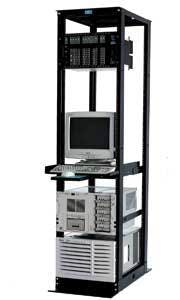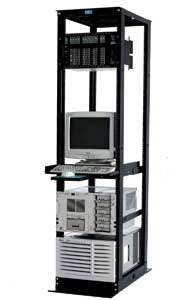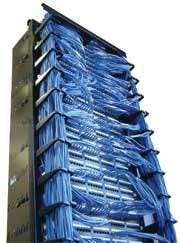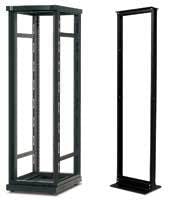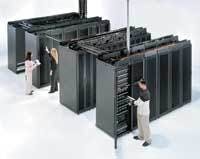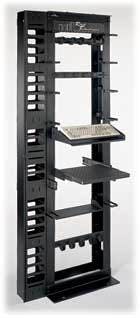Despite the influx of upmarket cabinets, open racks continue to be a better fit for some applications.
When it comes to choosing the racks and cabinets that will house expensive network equipment, data center managers are challenged with providing the cooling, security, space, and manageability needed to ensure reliability, uptime, and future growth capacity. While cabinets are typically considered the best option for housing network equipment, not all data centers are created equal, and open racks still have their place.
Playing it cool
"In any space where network equipment is being deployed, the biggest issue is heat; it's all about how to get it out of the room and out of the rack while keeping a 70° to 72° airflow at the front of the equipment," says Pat Johnson, product line manager for rack systems at American Power Conversion (APC; www.APC.com). "A full rack of equipment can produce up to 30 kW of heat that has to go somewhere other than back into the rack."
Depending on the data center’s physical design and the amount of control over air conditioning systems, there are two basic approaches to ensuring proper cooling. "Data center managers will either spread out the heat-generating sources around the data center and cool the entire room, or they will cluster all of their heat-generating sources and focus cooling in that specific area," explains Brad Everette, marketing manager for Superior Modular Products (www.superiormod.com).
According to Everette, in a data center that does not have a raised-floor system, there is little means for focusing cooling and controlling airflow, and it's better to spread out heat-generating sources. "There are still some data centers built on concrete slabs that require cooling of the entire data center with some type of AC unit in an effort to keep the electronics cool. In that situation, open two- and four-post racks allow better heat exhaust," says Everette. "But in a raised-floor application, you have the capability of pumping air up from the floor, and cabinets are the better choice."
While cabinets may seem to contain and foster heat within their walls, industry professionals agree that cabinets actually offer much better control over cooling than open racks. "With cabinets, you don't have to be dependent on the airflow in the overall data center," says Alan Taft, senior product manager with Chatsworth Products (www.chatsworth.com). "Cabinets offer several options for passive and intelligent heat control, like our patented chimney-type approach that naturally moves heat out of the cabinet and up into the plenum space, or active fans that can pull in cool air and move hot air out of the cabinet. You just don't have those options with open racks."
Adds APC's Johnson, "There is really no way to capture or manage heat with open racks. The heat just goes everywhere and creates hot spots. Then the heat easily re-circulates back around to the front, and all you're doing is putting hot air back into your equipment." According to Johnson, in large data centers with raised-floor systems, open racks are rarely utilized for mounting heat-generating active equipment.
Regardless of whether open racks are used to spread out heat-generating sources while relying on whole-room air conditioning, or cabinets with cooling options on a raised-floor system are deployed, keeping the equipment cool is the number one concern. "Too much heat in the data center can cause some attenuation in the data cabling, but even more so, it's going to reduce the life span of the active equipment," says Everette. " The life span of a switch or server that is typically 3 to 5 years could be reduced to just two years by having it run too hot. It truly is a quantifiable economic issue, and designers need to determine whether racks or cabinets are better based on the specific environment and application."
Taking a back seat
While open racks are less secure than cabinets, which can be fitted with locked doors, key-code access, and alarms, in most applications, security is often less of a concern than cooling.
"Security comes up all the time, but in many cases, it's dealt with at the room level, and the cabinets are not even locked," says APC's Johnson. "This makes it easier for the people that have access to do what they need to do. We see larger data centers and colocation centers restricting access at the cabinet level, and cabinets are also chosen over open racks in situations where the space may be used for secondary purposes, such as a janitor's closet or storage."
Because cooling is the number one priority, applications requiring both open racks and security typically deploy alternative security methods. "Although rare, I have been in large colocation data centers that were built on a concrete slab and, therefore, required the use of open racks to dissipate heat," says Superior Modular's Everette. "In that situation, the data center located groups of open racks in caged-off leased space and utilized a security surveillance system."
Rising to the occasion
While open racks don't provide security and may not be the best option for cooling equipment in a raised-floor application, they continue to be appropriate for holding patch panels and other passive equipment. And depending on the scale of the data center, open racks may also be the most economical choice.
"Open racks are still great for creating patch fields; they're an excellent way to manage and mount all of your passive equipment in a cross-connect scenario," says Everette. "We also see open racks still being used in the premise environment for telecommunications rooms (TR) where you'd never dream of having a raised floor system that can pump cool air up to the equipment." Everette points out that TR security is usually at the room level, and the equipment in a TR consists mainly of passive equipment and possibly one or two workgroup-level servers or switches to handle a specific floor.
"In the TR, the amount of heat generated is almost insignificant compared to the data center cooling world," he says.
CPI's Taft agrees that wherever numerous cables and patch cords are connected, open racks can be beneficial. "There are typically less cables connected to active equipment in the cabinet, but when there are many patch panels and copper Category 6 cables in a tight configuration, it's possible to get more real estate with a four-post open rack," says Taft. "That's why telco equipment and structured termination is a prime market for open racks. Plus, racks can be expanded by adding wider cable managers on each side"
Taft also points out that it's easy to swap out cable managers on open racks to accommodate the increased diameter of Augmented Category 6 cables hitting the market, whereas cable management built into older cabinets may not necessarily accommodate forthcoming larger diameters.
The cost of a cabinet can be anywhere from $1,000 to $2,000 more than a four-post open rack, but that difference is insignificant to many data center managers. "In high-end data centers, the manager is not going to skimp by buying racks instead of cabinets; you have to look at the value of the equipment it's going to house," says Everette. "If there's a 100 grand worth of equipment going into a cabinet, then the extra $2,000 is pretty insignificant to properly cool, protect, and display that investment."
In high-end data centers, open racks are not a big seller, and they never have been. CPI's Taft, however, points out that there are many smaller "data centers" where cooling, security, and aesthetics are not a huge concern. "If you just need a functional everyday place to mount equipment, and your room is secure with good AC and airflow, then open racks are just fine," says Taft. Because many schools, hospitals, and small commercial businesses tend to care more about functionality than aesthetics, Taft adds, they will often deploy open racks versus cabinets.
Taft compares open racks to average passenger cars while cabinets are more like Cadillacs. "High-end data centers, where millions are being spent to build the infrastructure, tend to be showcases; and data center managers want something that they're proud to show their customers. That's where the cabinets come in," he says. "Cabinets make everything look neat and secure, like the company is doing well. If you came into a large corporation and saw equipment mounted in a two-post open rack, you might question whether that company was planning properly."
Hanging in there
While open racks still have a place in the data center and premise environment, many manufacturers are focusing their efforts on cabinets. "Typically, we see just a few open racks in the corner of the data center for housing telco equipment, or maybe one or two at the end of a row of cabinets for patching," says APC's Johnson. "Our development focus right now is definitely on cabinets and enclosures."
For Chatsworth Products, two- and four-post open racks have been a key product line for many years, and the company plans to continue enhancing them as needed. "We have programs underway to enhance our four-post racks product lines, including modifications to the cabling management to accommodate Category 6A [Augmented Category 6] cable," says Taft. "We also recently increased the load rating on our standard two-post rack to 1,000 pounds, and our universal two-post rack to 1,500 pounds."
Taft admits, however, that a two-post rack is not something on which to mount a large switch or server, but the new load rating provides better assurance of the rack's strength, especially when loading it from top to bottom with patch panels. Chatsworth Products also recently introduced a space savings rack-mount monitor and keyboard for use with their open racks and cabinets.
"Racks are fairly simple, and there's not a lot you can do to them," Taft continues. "On the other hand, there are constantly new electronics and advanced features being added to cabinets, like remote monitoring and cooling systems. These features tend to be more high-end like the cabinets themselves. Although open racks are a lower-end product, I believe there's a place for them in the market, and the demand will continue to grow."
Superior Modular's Everette agrees that racks are here to stay: "There will always be a demand for racks. If construction is up, racks will be up. Open racks are sort of becoming a commodity, but we won't see a major spread in manufacturers. The logistics to import them from oversees is just too involved."
BETSY ZIOBRON is a freelance writer covering the cabling industry, and a frequent contributor to Cabling Installation & Maintenance. She can be reached at: [email protected]
